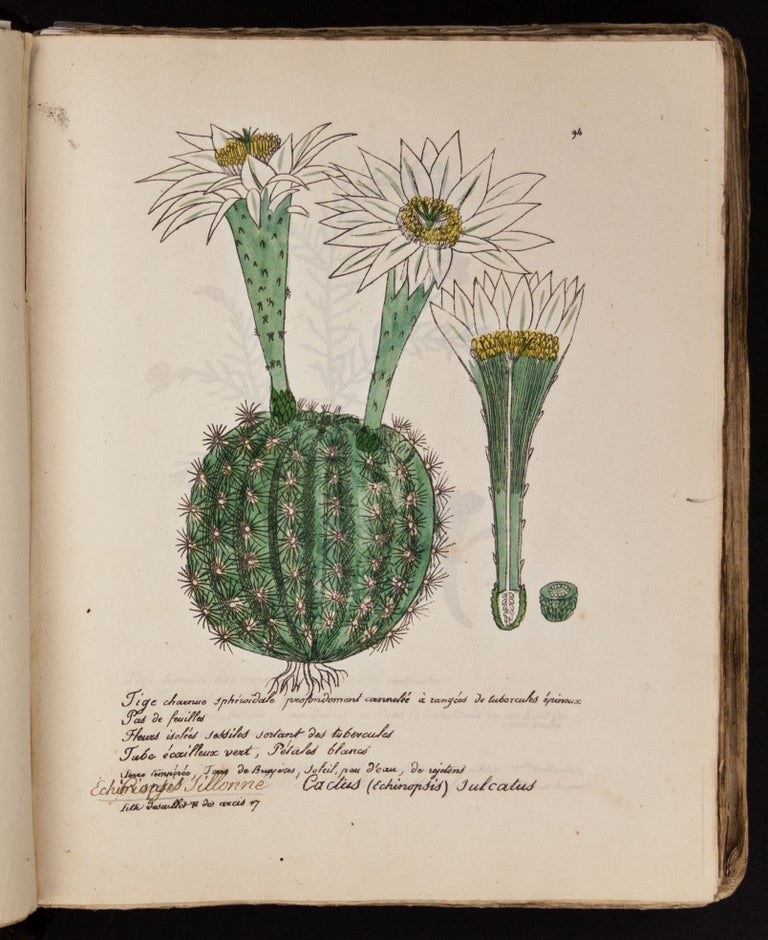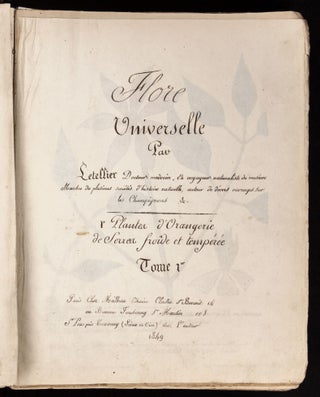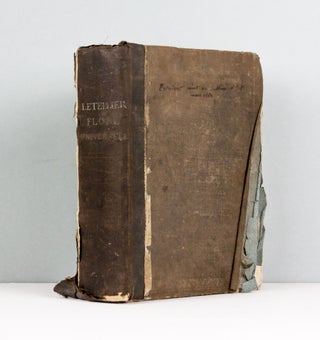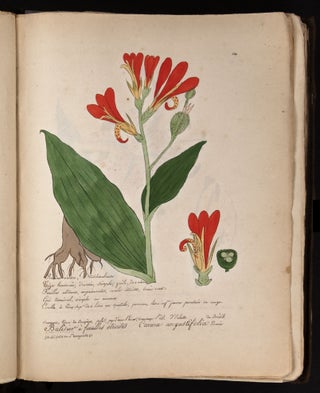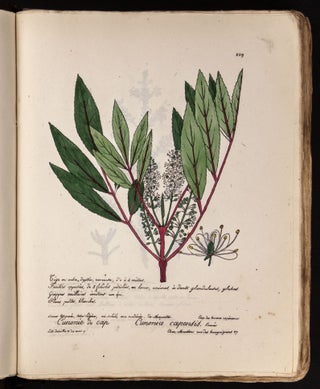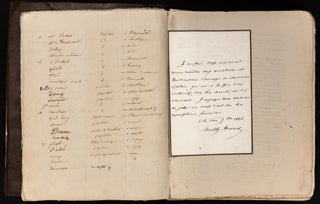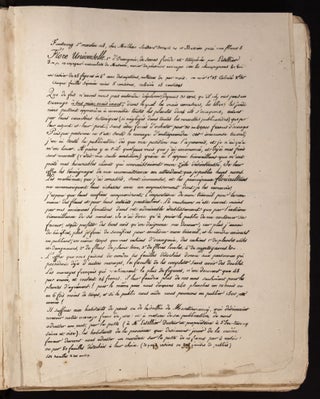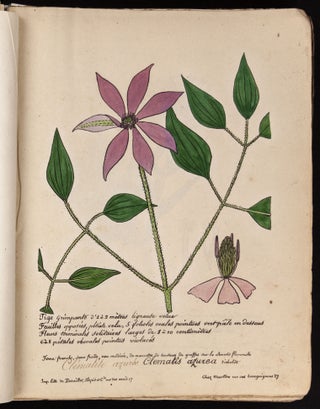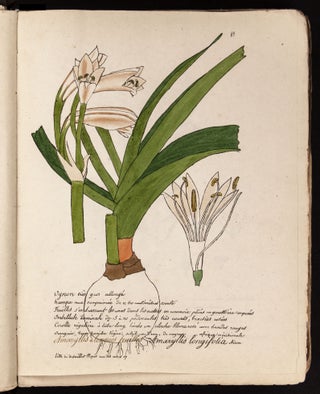Flore Universelle.
4to [28.5 x 23.7 cm], (1) f. blue letterpress wrapper to fascicle one (signed by the author), (1) f. manuscript list of subscribers, (1) f. manuscript testimonial by the subscriber Stuckly-Howard, (1) f. lithograph prospectus, (1) f. lithograph title page, 500 ff. hand-colored lithographs, 18 lithograph text leaves each bound at end of the relevant cahier [numbered (I-IX), X-XVII, (XVIII)], (6) pp. lithograph index of flowers, and with a dossier of duplicates/notes sewn into a newspaper wrapper (including duplicates of the prospectus, duplicates of texts I, IV-V, VII, IX-XV and XVIII, duplicates of flowers 426 and 448 [uncolored], a third copy of text XII, and a flower lithograph from another publication), as well as (12) ff. manuscript notes for compiling the index of flowers. Bound in contemporary cloth over pasteboards, manuscript title on spine. Spine and boards much worn, text block loosening. Letterpress wrapper wrinkled and with edge wear, occasional minor edge toning, edge wear, and spotting to prints, otherwise remarkably well preserved, with colors bright and fresh. Very rare French botanical atlas containing 500 vibrantly hand-colored lithographs of flowering plants suitable for cultivation in Parisian orangeries and greenhouses, here in what apparently was the personal, working copy of the author/compiler of this ambitious project, Jean-Baptiste-Louis Letellier, physician, mycologist, and ‘ex-voyager-naturaliste’ of the Paris Museum of Natural History. The Flore Universelle is a fine example of the democratizing potential of lithographic publishing in 1840s, with Letellier here almost single-handedly producing a reference work which, if produced in engraving or etching, would have required vast amounts of capital and labor. Instead, Letellier personally consulted Parisian plant-sellers to find the most recent imports (from as far away as New Zeeland and Australia), drew all the specimens himself, printed many of the sheets at his suburban home, and offered the work to subscribers by mail. The Flore Universelle is thus (in addition to being an impressive purely botanical publication) a primary example of how lithography allowed for low-cost, local, specialist publishing on the eve of the machine-press era, and in a manner that anticipates the ‘desk-top’ publishing of the 20th century. We have located only 4 institutional examples worldwide of Letellier’s Flore Universelle, and of these only one (British Library) contains the full complement of 500 plates as issued and preserved here. Our copy of the Flore Universelle is further supplemented with a hand-written list of subscribers, a testimonial of the work’s botanical utility signed by one of these subscribers, Letellier’s fascinating (and otherwise unrecorded) lithograph ‘prospectus’ explaining the genesis of the work and how it can be purchased, a dossier of several duplicate lithographs carrying manuscript notes, as well as a manuscript draft of a comprehensive index to the project. The first cahier of the Flore Universelle was published in the summer of 1846, with each monthly issue containing 25 floral lithographs (a lithograph leaf of hand-written text/diagrams was also included with each of the first 18 fascicles). Letellier apparently also offered the work as a complete volume at the end of its publishing run, as the present example is headed by a lithograph title page dated 1849. Letellier explains in his ‘prospectus’ that the project was intended as a capacious, precise, yet economical alternative to deluxe flower manuals, which cost exponentially more but included far fewer specimens and appeared with much less frequency. His manual “à bas prix, mais exact” was intended for ‘true amateurs,’ students, gardeners, botanists, florists, artists, and, fascinatingly, the professional horticulturists and ‘floriculteurs’ of Paris, who Letellier credits as valuable sources of ‘new, rare, and unusual’ specimens: As recompense for the knowledge he gained from this class of flower-importers, Letellier carefully notes when he has observed a plant in their shops, even providing the address where the reader can acquire such a specimen. The result is a who’s-who of mid-century Parisian nurseries, including the establishments chez Pelé, Les frères Cels, Martine, Chauvière, Thibaut, Bertrand, Vaillant, Lemichez, Keteleer, Michel, etc. Horticultural publications of the time note the unassuming visual register of Letellier’s drawings, but praise him for his ability to convey useful descriptive information with minimal pictorial fuss. Each leaf of the Flore Universelle includes a drawing of a whole plant and select details of its blossoms, leaves, roots, seeds, etc. Written notes offer brief information about growing environment (orangerie, heated greenhouse, unheated greenhouse, etc.), requirements for sun, water and soil, and if the plant is to be cultivated from seeds, blubs or cuttings. French and Latin nomenclatures are given along with ‘discovers’ and/or previous publishers of the species (Jacquin, Willdenow, Ker, Linnaeus, Aiton, Ruiz and Pavon, Cindon, Labillardière, Humbolt, Cavanilles, Robert Brown, Thunberg, etc.). Letellier includes species from Europe, Virginia, the Carolinas, Florida, Jamaica, Australia, New Zealand, South Africa, Mexico, Brazil, Peru, Chile, Colombia, New South Wales, China, Japan, the Canary Islands, Nepal, and India. In addition to noting if/where these plants can be found in local nurseries, he records if they can be seen in public spaces in Paris, e.g., Jardin du Muséum, Jardin d’Hiver des Champs Élysées, ‘hortus Paris’, etc. Letellier writes that cahiers are available uncolored for 1f. 25c., colored for 2f. 50c., and that individual leaves can be acquired (by those who have other manuals lacking only certain flowers) for 5c. per uncolored sheet or 15c. per colored sheet; he also offers a grab-bag option of 80 leaves. Interested parties may acquire the Flore Universelle in Paris from select booksellers, at Letellier’s home at Saint-Leu-Taverny in the neighborhood of Montmorency (some 20 km north of the city), or by post after sending inquires to Saint-Leu. Most cahiers of drawings and text, which are all apparently in Letellier’s hand, were printed in Paris at the (rather modest) lithographic firms of Desaillet & Llopis and Pelletier, although Letellier printed four cahiers himself at his home in Saint-Leu. Previous to the Flore Universelle, Letellier had published several works on mushrooms, especially species found in and around Paris (both edible and poisonous). These include Histoire et description des champignons alimentaires et vénéneux qui croissent aux environs de Paris (1826), Dissertation sur les propriétés alimentaires, médicales et vénéneuses des champignons qui croissent aux environs de Paris (1826), Figures des champignons, serant de supplément aux planches de Buillard (1839-42), and Avis au peuple sur les grands ressemblances et les petites différences qui existent entre les chanpignons vénéneux et alimentaires (1841). The Flore Universelle has apparently appeared at public auction just once (1984, Christie’s, 1000 GBP), and that copy contained only 400 plates. OCLC and KVK locate copies at the Bibliothèque nationale de France, the Muséum National d’Histoire Naturelle in Paris, the Smithsonian, and the British Library; Only the British library has the full complement of 500 plates (the others have only 400). * British Museum General Catalogue of Printed Books, vol. 15, p. 169; Annales de la Société Royale d’Horticulture de Paris, vol. 37 & 38 (1846-47), pp. 619, 578.

